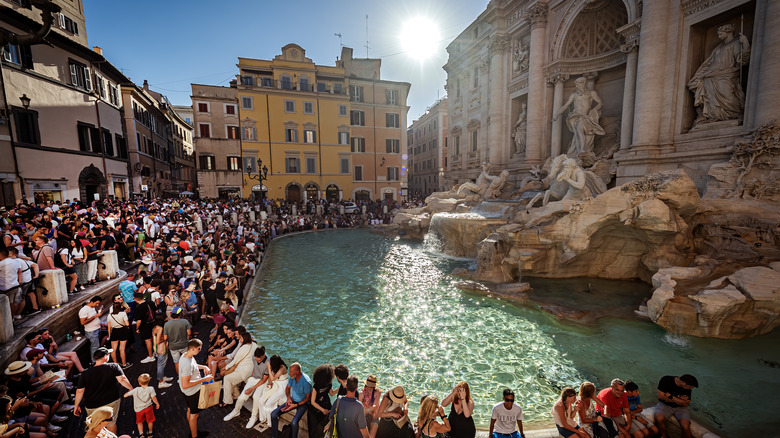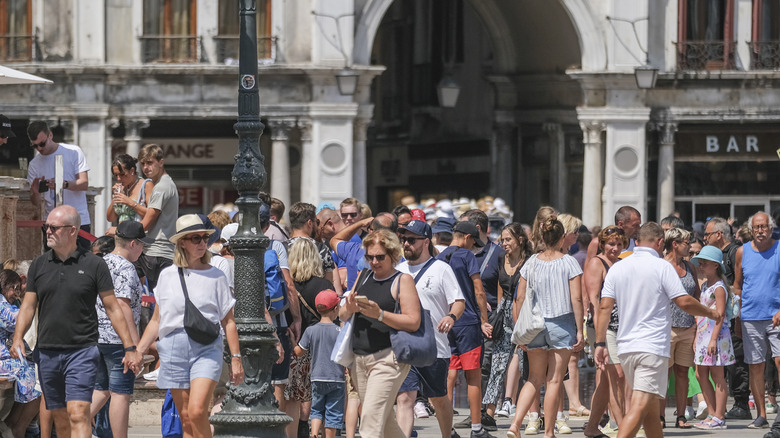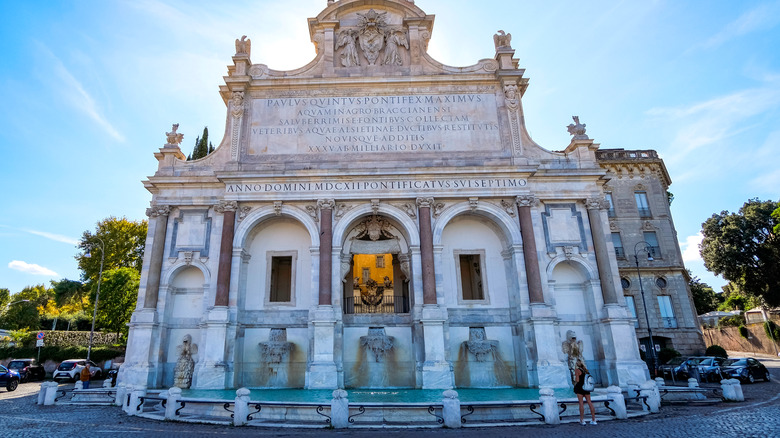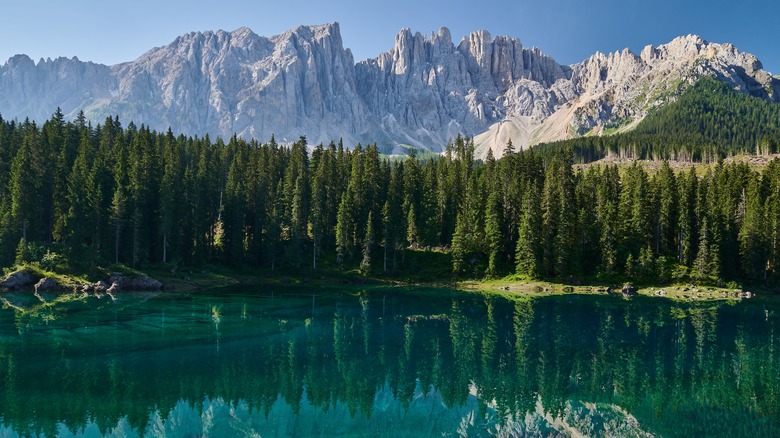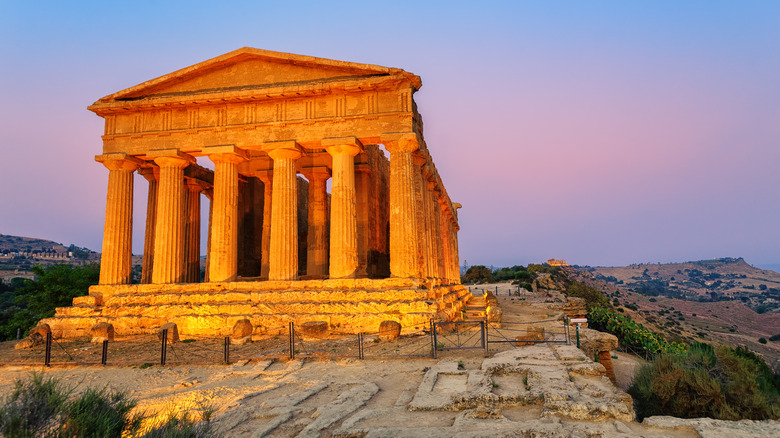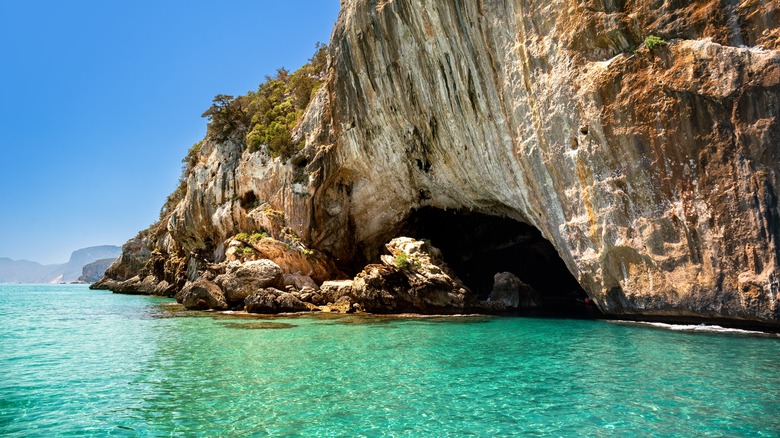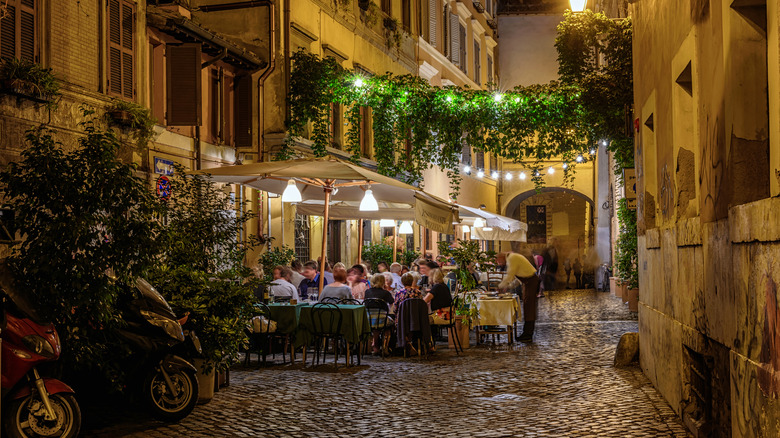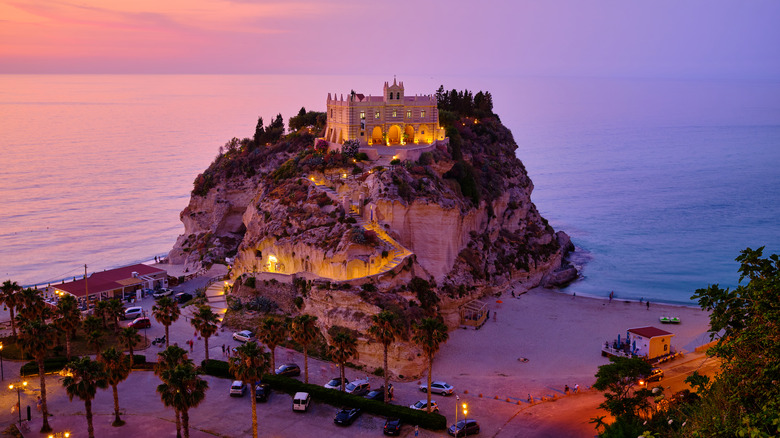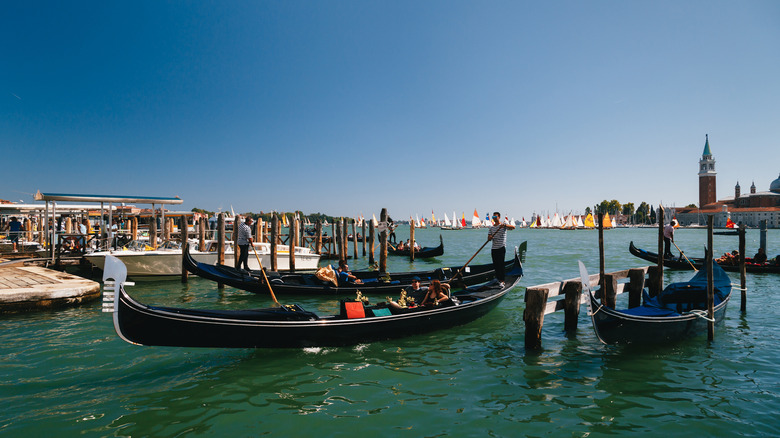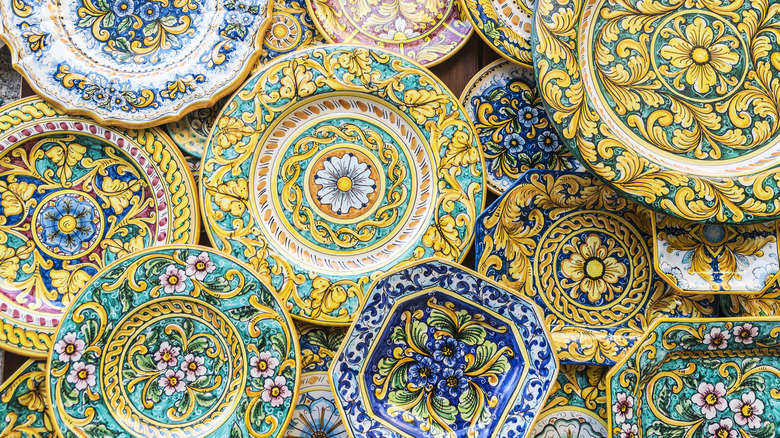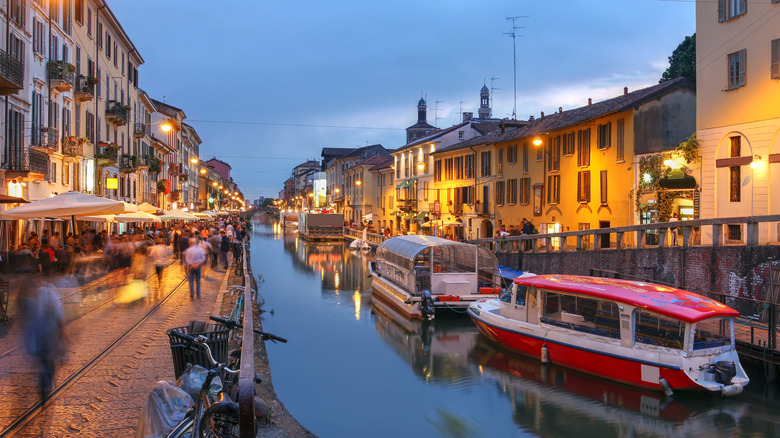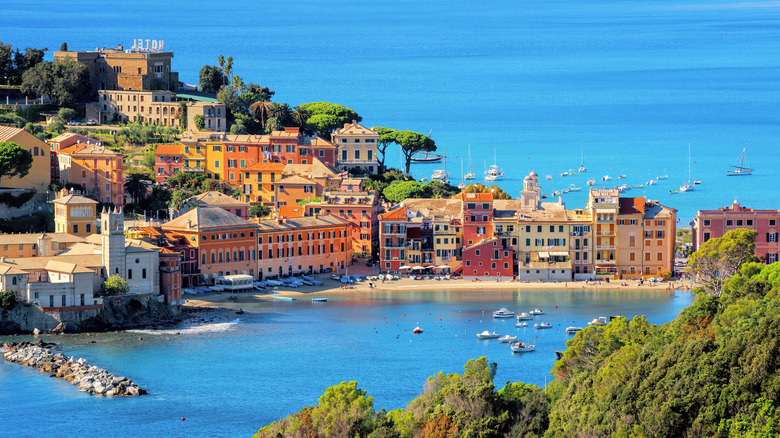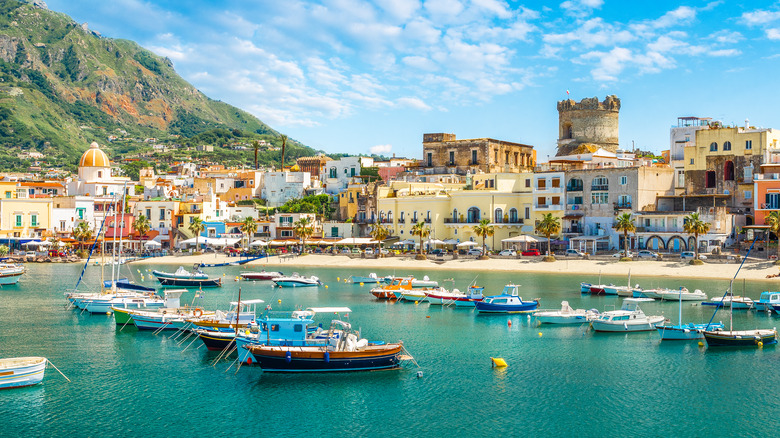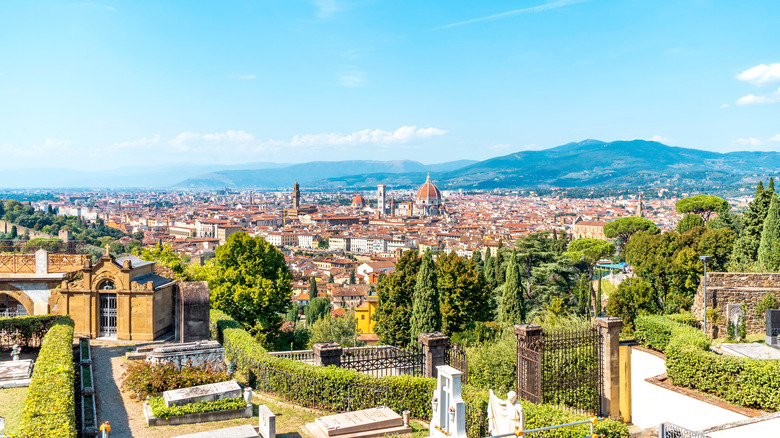Tourist Traps To Skip In Italy (And Where To Go Instead)
Italy numbers among the most visited countries in the world. Almost 80 million tourists travel there yearly (per Statista), and you can hardly blame them. The country offers fantastic food, cities of sublime beauty, marvelous beaches, fairytale-like islands, and the wonders of the ancient world. However, tourist traps will also abound when a destination reaches this level of popularity. Rome, Naples, Amalfi Coast, Cinque Terre, and Venice all regularly make headlines for overpriced food, rude staff in supposedly "authentic" restaurants, taxi and tour scams, and souvenir rip-offs. But the beauty of Italy is that you always have a better alternative.
So, how do you dodge the destinations, activities, restaurants, and shops with "tourist trap" written all over them? We've used our vast experience visiting Italy and combined it with the know-how from other travelers to answer that question. We've also taken into account Tripadvisor, Google reviews, and travel reporting from leading media outlets like The New York Times, The Guardian, and BBC. You should be able to enjoy being in a magical place like Italy without worrying about losing money and patience on rip-offs.
Skip the tourist traps of St. Mark's Square in Venice and go to the authentic cafes in the Dorsoduro university district instead
St. Mark's Square (pictured) is the epitome of Venetian splendor. The Byzantine architecture of Basilica impresses with golden grandeur, the silhouette of the 16th-century Campanile is as iconic as attractions get, and the arcades of Doge's Palace are an ultimate visual moment. That's the kind of scenery you want to enjoy with a cup of coffee sitting on one of the terraces that dot St. Mark's Square. Please don't do it; it's among the classic Venetian tourist traps. Google Maps is filled with angry reviews of the square's cafes. 11€ for a cappuccino at Aurora, 30€ for a bottle of water, and two Coca-Colas in Le Boulevard, and (are you ready?) €17 for an orange juice at Caffè Florian.
Skip St. Mark's Square cafes, for mercy's sake; there are better sestieri (local neighborhoods) where you can enjoy terrace life in Venice. Dorsoduro is one of them. Located in the city's south and encompassing the island of Giudecca, it's a less-crowded, more hip university district where you find regular prices and authentic Venetian cafes and eateries. Osteria Ai Pugni specializes in typical local snacks and offers splendid canal views, Campo Santa Margherita is a quaint square with colorful houses and cozy terraces, and Osteria Al Squero is a cicchetti (traditional Venetian small bites) go-to spot.
Explore Fontana dell'Acqua Paola instead of the Trevi Fountain in Rome
The Baroque 86-foot glory of Trevi Fountain is where Rome's grande belleza (the great beauty) lives. Unfortunately, this gorgeous structure also symbolizes overtourism. Come here during the day, and you'll be lost in the crowds that quickly fill up the narrow Piazza di Trevi in front of the fountain. Apart from selfie-taking tourists, expect annoying street sellers, a higher risk of pickpocketing, and rip-off restaurants and cafes in the vicinity. In other words, it's a lot to handle.
Fontana dell'Acqua Paola (pictured) is an alternative that's 150 years older than Trevi. Set on the Janiculum Hill near the Botanical Garden and Church of San Pietro in Montorio, it's a sublime white marble-clad sight with a vista over the Eternal City as a bonus. Remoteness from the buzzy city center and picturesque surroundings make Fontana dell'Acqua Paola a charming and peaceful visit and a perfect change from the chaotic Trevi experience. Also, you might recognize the structure from the opening scene of Paolo Sorrentino's "The Great Beauty" film.
Instead of the influencer-filled Lago di Braies, go to Lago di Carezza or Lago di Dobbiaco in the Italian Dolomites
Lago di Braies may be one of Europe's most beautiful lakes. It also suffers badly from overtourism that threatens its fragile ecosystem. The lake is crowded, and there's also restricted personal car access from July 10 through September 10. Moreover, the closest parking lot to the lake would cost you €38, and you'll likely find yourself in a traffic jam upon approaching the lake. That's the price you have to pay for being Instagrammable. Then, when you're on the lake, expect hoards of influencers fighting for the best selfie spots and queues for €50 boat rides.
For a much easier and stress-free experience, check out other lakes with the same killer views but fewer crowds and restrictions. Lago di Carrezza (pictured), with an awe-inspiring reflection of the Latemar mountain range, is a natural marvel located right next to the main road. Parking would cost you only €2. Lago di Dobbiaco, with fjord-like mountain vistas, is another roadside hit with easy parking and magnificent views of the Dolomites.
Instead of going to overcrowded Pompeii, discover the Valley of Temples in Sicily
Pompeii is among the most unique archeological sites in the world. As an ancient Roman city devoured by the lava of Vesuvius volcano and excavated to a fraction of the glory of its yesteryears, it's an enticing visit and an Italian must. But with mega popularity comes the tourist trap mentality. You'll encounter scammy fake information points, rip-off taxis from Naples, costumed "Romans" posing for photos and demanding money, and crowds everywhere you go. Visiting in the summer, especially, may be quite a challenge to endure.
While you shouldn't necessarily skip Pompeii, you may want to consider the alternatives, such as the spectacular Valley of Temples (pictured) in Sicily. One of the best sites to visit in Italy for history buffs, it's a UNESCO-protected complex of ancient Greek temples near Agrigento. Think Acropolis in Athens but transported into the hilly landscapes of the largest Meditteranean island and multiplied. It's undoubtedly one of the most beguiling European Greek sites and an underrated attraction. A whopping 1,300 hectares of area gives you plenty of room to breathe and ensures that you don't feel the presence of fellow tourists even during the peak summer months.
Instead of the Blue Grotto in Capri, go to the Bue Marino Caves in Sardinia
Blue Grotto on Capri is a sight to behold and one of the most beautiful sea caves in the world. Visitors enter through the narrow portal to discover the mesmerizing and otherworldly azure glow that awaits inside. But then you've got to consider that the boat won't spend more than 5 minutes in the cave, dips in the water are out of the question, and the entrance fee is €18. Moreover, you will queue to board the rowboat, and the whole tour will be rushed, uncomfortable, and soulless. Unfortunately, all of that qualifies as a tourist trap, and from June to August, coming to the Blue Grotto is a stressful affair.
Turn your attention to Sardinia for lesser-known but equally stunning cave adventures. Located among the splendid coastal beauty of the Gulf of Orosei, the Bue Marino Caves (pictured) are a great alternative to Blue Grotto. They offer dramatic turquoise sea vistas, a one-hour guided tour inside the stalactites-filled subterranean heart, and scenic boat rides along the stunning Sardinian coast.
Instead of visiting touristy restaurants near major Roman attractions, go to Trastevere for authentic local fare
One of the golden rules of not getting ripped off in a restaurant in Italy is avoiding places that overlook iconic Roman monuments. The press is filled with stories of tourists paying more than €100 for a lunch near St. Paul's Basilica or two orders of spaghetti costing €430 near Castel Sant'Angelo. You don't want to spend a fortune on a scammy restaurant falling for one of Italy's most well-known tourist traps. The best way to avoid such a fate is to get away from the major tourist areas like the Colosseum, Trevi Fountain, Piazza Navona, or Vatican City and head to the more authentic and better-priced neighborhoods.
You should dine in Trastevere to eat like a local. You may know the name from the recently released song by Italian Eurovision winner Måneskin. It is a former working-class district full of medieval architecture and atmospheric cobblestone streets bordered by the scenic River Tiber. Locals, ex-pats, and tourists mingle there, dining in cozy Roman trattorias, enjoying the terraces of hip cafes, and sipping locally-produced wine in the hole-in-the-wall bars. It's the ultimate place to encounter the real Rome and pay the normal price for mouthwatering food and drinks.
Calabrian coast instead of Amalfi
Oh, wonderful Amalfi. Cliffside towns overlook the blueness of the Tyrrhenian Sea, chic terraces of restaurants with extra-photogenic backgrounds await couples, and beaches lure with fashionable bars. However, the idyll is broken the moment you encounter endless traffic jams on crammed narrow roads, see the sky-high prices in local eateries that lost authenticity years ago, and book your accommodation paying more than you should. Yes, this part of Italy is irresistible. But hoards of tourists have changed the marvelous landscape into a playground for Instagram with a hefty price tag. In summer, the Amalfi Coast reaches the peak of its capability to accommodate thousands of visitors. You want to head elsewhere to spend your money better.
The underrated Calabrian coast is the answer. It's all cliffs, historic villages, and glamorous beaches, too, without overcrowding and rip-offs. It's that Italy everyone seeks in Amalfi: simple, accessible, a bit unorganized, but incredibly charming in the end. Start at the stunning town of Pizzo Calabro, proceed to the dramatic cliffside Tropea (pictured) with spectacular Rotonda Beach, explore the endless blue beaches of Capo Vaticano, and head all the way down to picturesque Scilla, which is among the most beautiful villages in Italy.
Take a traghetto instead of the gondola in Venice
To gondola or not to gondola, that's the pressing question for every Venice visit. Let's stop for a moment and think about what you're really getting by paying about €90 for a 30-minute ride. Yes, the vista of palazzos from the canals is undeniably charming, but it's also the same view you can get from any other means of transport in the city. Sure, the serenading of the gondolier is special, but he does that for everyone else. Finally, you can get stuck in a "canal jam" with other gondolas lining up to proceed through narrow water passages, and it's far from a comfortable experience.
Why would you pay €90 for a gondola if you can pay €2 for a traghetto? The latter is a shared wooden boat, another typical Venetian way to move around from one side of the Grand Canal to the other. It's much shorter, with no singing involved, but it boasts the same level of authenticity as the gondola. And then you can always complement your waterborne experience by buying a Venezia Daily Pass for €25 that will allow you to board as many vaporetti (Venetian larger public transport boats) as you want, and go to other islands of the Venetian lagoon, such as Burano and Murano.
Instead of buying tacky souvenirs near the famous monuments, look for local artisans
Not everyone enjoys souvenirs; the best memories are those you carry inside. But if you still want to bring something home, getting ripped off in Italy is very easy. After all, it's the country of the Pisa Tower and the Colosseum; how can you resist having a mini version of a famous monument proudly hanging on your fridge? While the smaller souvenirs won't usually do any harm to your budget (although, don't spend more than €10 on a magnet), it's the seemingly authentic symbols of regions (think limoncello in Sorrento, carnival masks in Venice, glass in Murano, high-fashion brands in Milan) you're visiting that can get you scammed.
Two main rules are avoiding street vendors at all costs and doing your research beforehand. Italy is a country of artisans, centuries-old traditions, and some of the best food products on Earth. Don't fall for flashy sales tactics, avoid overly touristy showrooms promising the "most Italian" experience, and always go local. For artisans, use Homo Faber Guide to locate the ateliers and galleries. For fashion, only go to the official boutiques and avoid resellers; for food souvenirs, opt for locally-owned stores specializing in regional produce.
Dine in Navigli instead of the Duomo area in Milan
When it comes to tourist traps in Milan, everything is pretty straightforward. The main scammy "action" is focused on a small area around the splendid spired Duomo and frequently Instagrammed Galleria Vittorio Emanuele II shopping arcade. Long story short, if you decide to have a drink or dine with a view here, you're guaranteed to pay double or triple the price of the city's standard. Moreover, there's a risk of pickpocketing, omnipresent street vendors will spoil your day, and crowds of fellow tourists will try to strike the best pose with doves and the cathedral. Have a stroll there, get to the top of Duomo for the views, and take a pic or two inside the elegant 19th-century-built gallery. Then, go to more wallet-friendly and authentic parts of the city.
Check out Navigli (pictured), one of Milan's most charming, easygoing, and pleasant neighborhoods. Five canals form this quaint part of the city known for joi-de-vivre and a diverse choice of bars, cafes, street food joints, and elegant osterias. You will feel the beat of actual Milan, the one that's defined by locals and not by tourist-focused, overpriced restaurants and scammy street vendors.
Instead of Cinque Terre, go to Sestri Levante
Cinque Terre is one of a kind. The beauty of these five UNESCO-protected villages is unrivaled, the epicness of the craggy Ligurian coastline is absolute, and you will find some of the most picturesque vistas on the planet. But such splendor has a cost, and overtourism is its name. Sadly, the warm months turn this fragile, sublime area into a noisy, Disneyland-like location packed with often poorly behaved visitors competing for selfie space on narrow coastal hiking trails. Of course, you can't blame people for wanting to touch the beauty, but tourist trap restaurants and high prices come with "Instragrammization."
If you want to avoid that, spend your money more wisely, and still get a glimpse of that elusive Ligurian magnificence, head to Sestri Levante (pictured) and its Riviera. Comfortably located between Genoa and Cinque Terre, it's a land of colored villages, scenic beaches, and inspired cliffside coastal panoramas — just without the frenzy and with underrated charms. During the summer, it's a perfect alternative to crowded Cinque Terre. You can visit both in winter and early spring with peace of mind.
Choose Ischia over Capri
Hardly any other island in Italy is as cinematic as Capri. But with only 4 square miles of size and 2 million visitors per year, it can get really crowded. Then, an air of exclusivity helps high-end resorts and upmarket restaurants draw celebrities and wealthy folk to the island's dramatic shores. The same atmosphere of upscaleness nurtures the tourist trap restaurants in Marina Grande and Capri towns and makes visiting the island feel like a heavy burden on your wallet. While the mythical beauty of Capri is most certainly justified, the prices can reach outrageous heights.
But there's always an alternative. Ischia, a fellow wellness-focused island in the Bay of Naples, stands as a less touristy, better-priced destination with comparable postcard-perfect vistas. It's almost 18 square miles, has more space, offers more accommodation options, and boasts an underdog allure. The volcanic origins bring unique mountainous landscapes and bigger scale gifts with a variety of beaches to enjoy.
Beware of the tourist trap restaurants and choose eateries that serve regional food instead
Tourist trap restaurants have found fertile ground in Italy. The basics of detecting one are pretty simple. Never opt for an eatery right next to a famous attraction. Be it the Colosseum, Duomo, St. Mark's Square, or Vatican City, you will regret your decision to settle for an alluring terrace "with a view." The regret will materialize in an unpleasant check with seemingly unbelievable rip-off prices. Flashy images in the menus outside the venue, overly friendly promoters that fight for your attention, kitschy terraces, and interiors that scream "authentic Italian" are some of the sure signs you're dealing with a tourist trap.
While pizza and pasta are beloved staples of Italian cuisine, this country is all about regional traditions. For example, pizza Margherita may be a dominant food in Naples, but it is not that common in, say, Genoa, where focaccia reigns supreme. Do your research on the region you're visiting, know what it's eating, and look for eateries that serve that. Avoid uber-central areas and go to the quaint outer neighborhoods. And always trust your gut; if the restaurant seems sketchy, it probably isn't worth your money.
Head to San Miniato al Monte instead of Piazzale Michelangelo in Florence
On one hand, you can't beat the panorama of Florence from Piazzale Michelangelo. On the other hand, the place is among the tourist traps in Italy you need to avoid. During the high season, this neoclassical square-turned-parking-lot becomes a poster child for overtourism with an abundance of street vendors, pickpockets, and excessive prices at the questionably named Vip's Bar on-site. Still, this place is one of the best viewpoints in Florence, and you would miss out on not coming there to contemplate and shoot pictures.
You should also know that a much more rewarding viewpoint awaits you 6 minutes away on foot. We're talking about the Romanesque jewel San Miniato al Monte Basilica. A Florence Duomo-reminiscent white marble facade greets you there, tranquility abounds at the Porte Sante cemetery, and magical views of the city unfold. You'll be even higher above Florence than Piazzale Michelangelo, so the iconic panorama of this Tuscan gem is all yours to enjoy—minus crowds, annoying vendors, and overpriced restaurants.
